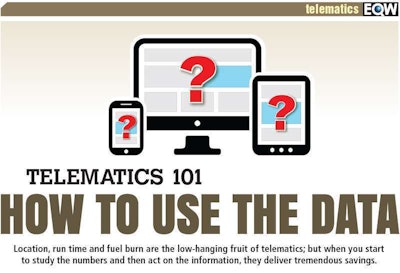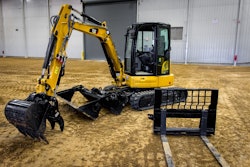Editor’s Note: This is the second part in our ongoing Telematics 101 series of articles. To view the other articles in this series Click here.

Contractors sometimes complain that reading telematics data is like trying to take a drink from a fire hose – too much information, too fast.
True, OEM and third party telematics offerings can give you a ton of data to look at.
Then, there’s the Association of Equipment Management Professionals/Association of Equipment Manufacturers (AEMP/AEM) Telematics Standard Version 1.0 (which gives you four key data points), and the upcoming version 2.0, which yields 19 data points and dozens of fault codes.
RELATED >> Telematics 101: Cutting through the jargon to what you need to know about fleet tracking tech
So there’s your fire hose. To help you start making sense of it, let’s look at three of the most common and most useful data points: asset location, run time and fuel burn. These are available on most manufacturer telematics portals and through the AEMP/AEM Telematics Standard Version 1.0. In future Telematics 101 articles, we will continue to explore the different ways contractors are using the data to improve safety, drive costs down and increase productivity.
Keep in mind that reaping the benefits of a telematics system is an exercise in creative business analytics. Some users only want to keep track of their assets, but many fleet managers and construction companies are compiling and analyzing the data in ways that help them fundamentally transform their business. The key to finding value in this data deluge is to figure out your goals first. Then, build a data collection plan that will support those goals. Then, act on the information.
Location
Knowing where your equipment is at any time brings a host of benefits. If you want to keep track of when equipment enters or leaves a particular area, you can set up a “geofence” using GPS coordinates. Anytime that asset moves into or outside its fence, you can have an alert emailed or sent to your phone. This can prevent unauthorized use, and alert you to potential equipment theft as well.
Geofences used to be circular, but they’ve evolved to include square shapes and polygons, and now you can even set up a geofence to follow a river, a railroad track, or an interstate. This latter development is particularly useful for asphalt pavers. For example, it enables you to gauge exactly where the dump trucks are in relation to the paving machine that’s moving down the road. Armed with this knowledge, you can speed up material delivery to keep the paver moving, or slow things down to prevent choke points.
Real-time monitoring of material trucks will also help you gauge asphalt plant output. If your trucks are caught up in traffic, you can make adjustments to their routes based on traffic information and avoid congestion.
In addition to real-time tracking of assets during a job, you can use your geofence to count cycle times (as trucks move in and out of an area). Compiling accurate estimates of how many loads it takes to complete a particular job will help you create much more accurate and competitive estimates for future bids.
Location data will also help your service technicians find equipment when they go into the field. On a large highway or civil engineering job, machines are often stretched out over many miles. Using telematics, the techs and fuelers can go straight to the machine requiring service, rather than wasting valuable time hunting for it.
For property tax purposes, location data can also be used to verify where the equipment is kept, or working. If your offices are in a high tax state, but you have substantial assets working out of state, you may be able to use this information to reduce your property tax bill.
Run time
Run time data is a simple measurement that tracks when the equipment is turned on and when it’s turned off. This allows you to set up simple curfews for your machines. If somebody cranks up a machine that should not be running before or after work hours, you can set up your telematics system to send you an alert. Or, you can get more sophisticated, and actually disable the starter during specific hours.
Short term, run time can also serve as a time card. If a driver says he started work at 7 a.m., but the truck didn’t crank until 8 a.m., you may want to investigate.
But the greatest benefits of having your run time data come from compiling it and using it as a scorecard. If you know to-the-minute how many machine hours it took to complete a specific job, or move a specific amount of material (and how much fuel you burned), you’ll be able to craft much more accurate bids for future jobs. That information can also be used to schedule maintenance and help your operations people forecast job completion dates.
Long term, you can compile run time data into a spreadsheet and glean useful insights into your equipment utilization. It’s a well-established fact that site supervisors sometimes ask for more machines than they need because, in a pinch, they may need that extra machine. With a history of run time data, fleet managers are in a better position to argue for fewer machines. Low utilization rates can trigger beneficial conversations about jobsite organization, or the feasibility of using rental equipment instead of company-owned assets.
It’s not unheard of for construction companies to reduce their utilization as much as 10 to 15 percent using telematics data. This not only means you use fewer machines to do the same amount of work, but also that all the costs associated with ownership (including insurance and bonding) go down as well.
Fuel burn
At the end of the day, knowing which machines need refueling, and which do not, can be a huge time saver for your fueling operations or fuel provider. Some fleet managers even leverage that data with their fuel vendors to negotiate better prices.
Fuel burn statistics can also be an excellent indicator of engine lube oil condition, and help you establish a more accurate, condition-based maintenance program. Most contractors change lube oils on an hourly basis, 250 or 500 hours typically. But, if you have a machine in heavy applications burning above-normal levels of diesel, you may want to consider changing that machine’s lube oil ahead of schedule, or at least keep it on a watch list for more frequent oil sampling.
And since fuel is almost always the biggest operating expense in earthmoving, keeping accurate records of fuel burn can give you valuable job costing data for competitive bidding purposes. Some contractors are even taking their fuel consumption data to their equipment dealers and using it to bargain for better prices – especially when they can prove that a particular brand and model of machine consumes more fuel than a comparable model from a competitor.












